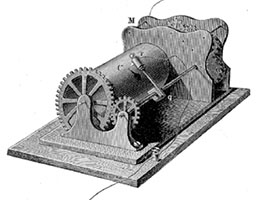 The notion of fax , coming from the English language, is an abbreviation of facsimile (or facsimile , in our language). The term has several meanings within the same context.
The notion of fax , coming from the English language, is an abbreviation of facsimile (or facsimile , in our language). The term has several meanings within the same context.
The first meaning of fax mentioned by the Royal Spanish Academy ( RAE ) in its dictionary refers to a system that enables the transmission of graphics and texts through the telephone line . By extension, the machine that allows this communication and the document that is sent or received through this method is called a fax.
In essence, this system requires a fax machine to scan and process the document to be sent; a telephone line through which data circulates; and another fax machine, this time to reconvert the information and print the document.
Suppose that a person who is in Madrid ( Spain ) wants to send a contract model to another individual who is in Montevideo ( Uruguay ). Whoever is in the Spanish capital takes the contract model and inserts it into the fax machine to scan it: the text is thus converted into a bitmap (a still image). This bitmap travels along the telephone line to which the fax is connected and reaches the recipient's fax machine, in Uruguayan territory. There, the receiving computer performs the reverse process, reconverting the bitmap and printing it on new paper.
This type of communications was very popular for several decades. However, with the advancement of digital technology and the development of the Internet , it lost preponderance and is almost not used today. It's faster, easier and cheaper to send and receive documents using email or other web- based systems.
History of the fax
 Despite what it may seem, the fax machine emerged long before the telephone. In fact, it was part of the so-called Information Age , as one of the new means by which human beings sought to communicate efficiently and economically. Together with the telephone and the telegraph, among other inventions, they laid the foundations for the degree of global interconnection that we enjoy today thanks to the Internet.
Despite what it may seem, the fax machine emerged long before the telephone. In fact, it was part of the so-called Information Age , as one of the new means by which human beings sought to communicate efficiently and economically. Together with the telephone and the telegraph, among other inventions, they laid the foundations for the degree of global interconnection that we enjoy today thanks to the Internet.
The person who created the technology necessary to send an image by means of a cable was Alexander Bain , of Scottish origin, and this led to him being recognized as the inventor of the fax. His work dates back to the first half of the 19th century; Already in 1843, he was developing a prototype that took advantage of electricity and combined it with the telegraph .
One of Bain's first experiments consisted of mounting two pendulums with needles to synchronize their movement by means of a clock, thanks to which it was possible to scan a surface one line at a time and send it to a receiver. Although he did not create the device itself, in May 1843 he patented a document in which he detailed a series of improvements to produce and regulate electric currents in fragments of time, telegraphic signals and electrical printing.
In 1851, an English physicist named Frederick Bakewell invented a "picture telegraph" that closely resembled the fax devices we know today, and offered improvements over Bain's creations, such as the use of rotating cylinders in instead of pendulums to achieve superior image quality.
It was only in 1862 that Giovanni Caselli , an Italian physicist, made a machine called the pantelegraph , which was also based on and improved on Bain's invention . This device was the first to be used commercially to transmit images.
